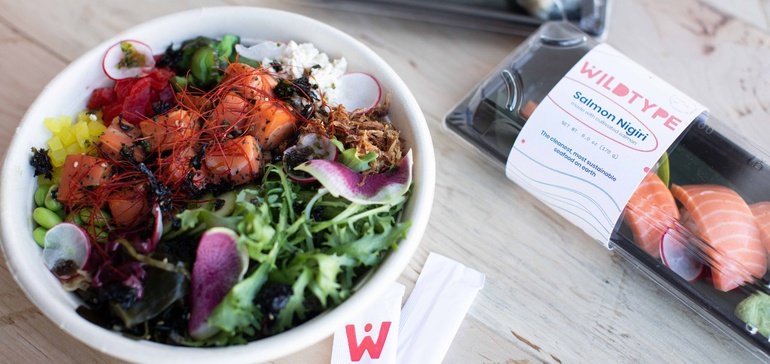Wildtype agreement will bring cell-based sushi to grocery stores and restaurants

Dive Brief:
- Cell-based seafood maker Wildtype signed distribution agreements with grocery store sushi bar operator Snowfox and fast casual restaurant operator Pokéworks.
- These agreements pave the way for the public to get a taste of Wildtype’s sushi-grade salmon made from cultured cells. Snowfox operates in 1,230 grocery locations nationwide, while Pokéworks currently has 65 locations, with plans to grow to more than 100 in 2023. Wildtype said that its salmon will first be available in fine dining restaurants as it scales up.
- This is the largest and most direct partnership in the U.S. between a cell-based seafood provider and foodservice companies. Wildtype’s San Francisco combination production plant, tasting room and educational center went into operation this summer.
Dive Insight:
Considering the ongoing work to create a regulatory framework for cell-based meat and seafood, not to mention the task ahead for individual companies to meet the requirements so they can sell their products to consumers, it’s unclear just when these items will be available in the United States. Once that happens, however, these new agreements Wildtype has signed make one thing clear: Consumers will have an opportunity to get a taste of the products in relatively affordable and easily accessible venues.
Because Wildtype’s salmon comes from bioreactors and is not pulled from the ocean, it helps foster diverse ocean communities and does not rely on the traditional fishing industry, the company said. In a statement, Wildtype said it sought out mission-aligned companies for these partnerships to help promote a more sustainable future seafood industry.
“What Wildtype is doing has the potential to lead the food business toward a completely different value chain,” Snowfox CEO Stacy Kwon said in a statement. “Snowfox is proud to partner with Wildtype and support the company’s scientific breakthrough.”
Once sounding like the stuff of a futuristic novel, the cell-based meat space has made significant strides in the past 12 months, and is getting closer to being an actual consumer choice. Cultivated chicken made by Eat Just has been available in Singapore for about a year. In 2021, new production facilities have started operation for Wildtype, Israel-based Future Meat Technologies and California-based Upside Foods. And relationships have formed between cell-based meat makers and existing food companies and distributors, including a collaboration between Nestlé and Future Meat Technologies to explore the possibilities of cultivated meat and an agreement between Upside Foods and Michelin-starred chef Dominique Crenn to serve cultivated chicken in her San Francisco Atelier Crenn restaurant. There have also been distribution partnerships to bring cultivated meat from Israel’s Aleph Farms and California’s BlueNalu to different nations in Asia, Europe and South America.
Wildtype’s agreement is much more specific and would literally bring cultivated seafood to the masses. While cell-based meat has been heralded as a future way to feed the world high-quality protein, high costs and relatively low yields have made it seem like it will be a high-end dish, at least in the beginning. Grocery store sushi bars and restaurants like Pokéworks cater to people in all economic classes. Considering the minimal processing and preparation work that needs to be done for salmon to be used as sushi or in a poké bowl, these products are also likely to show off the form and flavor of cell-based seafood.
Because there is no regulatory framework for cell-based seafood yet, it’s hard to say when products from Wildtype — or any other company making cell-based meat for the U.S. — will become available. Wildtype has said that it’s been working with federal regulators since late 2019, providing them with details about processes and products, which may help it get through the approval process more quickly. The company’s 7,700-square-foot pilot plant, which opened in San Francisco in June, is configured to make 50,000 pounds of seafood a year. Wildtype said the plant’s maximum capacity is more than 200,000 pounds of seafood a year — enough for a fair amount of sushi.
Source: fooddive.com

